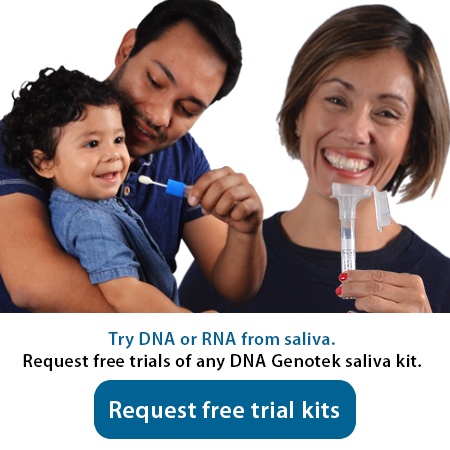2013-02-20
Rafal Iwasiow is Vice President of Research and Development at DNA Genotek. This article was written with contributions from Carlos Merino, Rob Shipman, Anne Bouevitch, Ashlee Brown, Christina Dilane, Evgueni Doukhanine, Mike Tayeb, Bitapi Ray, Cassandra Kelly-Cirino, Jacques Niles, and Adele Jackson.
Recently, DNA Genotek’s research and development team attended the “Genomics: the power and the promise” meeting in Ottawa, Canada put on by the Gairdner Foundation and Genome Canada. It was an event that my team enjoyed greatly and it was in our home city – you can’t get more convenient than that. The meeting attracted a diverse group of scientists interested in hearing from world class researchers on a broad number of genomic topics. The topics ranged from human health, anthropology, livestock breeding, plant genetics, and even alternative energy. The talks opened our minds to the future power of genomics while demonstrating how far we have come since the human genome was first published. Following the meeting, my research and development team thought it would be beneficial to provide a summary of the sessions we attended at this conference. We hope you enjoy our synopsis of talks by (Dr. Eric Lander, Phillip Sharp, Svante Paabo, Tom Hudson, Peter Jones, Stephen Scherer, Michael Hayden, Bartha Maria Knoppers, Curtis Suttle, Michel Georges, Kluas Ammann).
- The common perception that the genome is more than a simple collection of genes has changed in the past few years. The genome is a complex and dynamic system that relies on the proper regulation of protein-coding genes and other types of regulatory elements (ie. miRNAs, snoRNA etc.). Through the study of such elements, the scientific community will eventually understand the principles of gene regulation, helping to identify and treat many diseases in the future.
- There have been 3 major revolutions in genetics.
- The discovery of DNA structure, genes, genetics, etc.
- The exploitation of DNA via genomics
- The integration of life sciences at the molecular level with physics, engineering, computational methods, mathematics and more. This is termed the new biology for the twenty first century. This integration needs to provide an approach to producing a higher yield of food crops with a lower level of environmental impact; address world hunger by addressing the local/global food distribution problems; and address world fuel shortages with programs that promote crop production for biofuels.
- We have learned a lot from studying the genome of living people and extinct humans. The Neanderthal genome has been compared to the genome of people today with the outcome showing that there are significantly more matches between Neanderthals and Europeans than between Africans and Neanderthals. Today, people living outside of Africa carry approximately 2.5% of their genome from Neanderthals.
- There is a need for genetic information to advance personalized cancer medicine:
- To help mitigate risk by screening for detection at the earliest stages
- For precise diagnosis
- To develop new therapies for more effective treatments.
So what could the future of cancer medicine hold? We could see many more treatment decisions impacted by molecular profiling which would match treatment to specific patients. - Research indicates that there are genetic factors involved in Autism Spectrum Disorders. There have been recent advancements with researchers showing use of microarrays as a diagnostic tool for autism. Future advances could lead to earlier diagnosis and early intervention.
- Some disease factors go beyond the genetic code and involve methylation of DNA. Epigenetics: heritable changes in the genome other than changes to the DNA sequence, commonly DNA methylation and histone modification. These changes lead to increase or decrease in accessibility of the DNA through chromatin folding, thus increasing or decreasing gene expression. Certain cancers have been linked to epigenetic changes believed to occur due to nutrition and lifestyle choices.
- A principal problem in medicine is that clinical trials show treatment efficacy in populations while physicians treat individuals. Individual patients vary widely in their response to specific drugs which can lead to a larger than expected number of adverse drug reactions. Currently, patient genotypes are not used as part of patient treatment plans. Researchers are now generating a large database of reported adverse drug reactions which is being used to help understand the genetic basis of these reactions. Research like this could lay the groundwork for changes to clinical practice and treatment recommendations with the ultimate goal being a reduction in the number of adverse drug reactions.
- Our world is changing rapidly as people can obtain their genetic data by providing a simple saliva sample. However, the regulations and policies around sharing of genetic data are lagging behind the technological advancements. Genetic data is most useful when it is shared, however, there must also be policies to protect people’s privacy.
- The use of genetically-modified (GM) crops to help address one of the most pressing global challenges, food security and sustainable farming, is a highly contentious topic, especially in the EU. Modern biotechnology can overcome certain limitations of conventional breeding and thereby help provide farmers with safe crops that are higher yielding, are less dependent on pesticides and fertilizers, or have higher nutritional value. Unfortunately, some policymakers in Europe have hastily reacted to unsubstantiated claims from flawed research about the adverse effects of GM crops by imposing bans or stricter rules and seriously jeopardizing the contribution of biotechnology research to human well being, particularly in developing countries.
- In the agricultural environment, non genomic approaches to high breed selection require a considerable amount of time and money invested, with estimates as high as $350,000/breed. The same genomic approaches that have been used for human health over the last 10 years are now starting to enter the livestock market and hold promise in helping the detection of high breed value cattle at an early age, thus saving considerable amounts of time and money.
- The greatest biodiversity on earth might actually be in the ocean. There are more than 10 million viruses plus 1 million bacteria in 1L of marine water.
The research and development team found this meeting to be very insightful as it presented where genomics has been, where it is now and where it could potentially go next. I hope that you found some of these summary points interesting. Did any of them surprise you?


